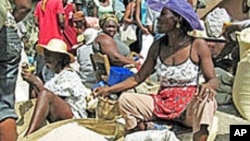A severe drought in Haiti has led to acute water shortages, shriveled harvests and raised food prices, weakening the fragile food supply and worsening hunger among the poor, the U.N. World Food Program (WFP) said.
The poorest country in the Americas, Haiti already struggles to feed its population of 10.4 million, and 600,000 Haitians already rely on international food aid to survive, the WFP says.
"Thirty percent of the population is moving into food insecurity. That means families are having reduced ability to purchase food and have had to reduce their calorie intake. Families are now having fewer and smaller meals," said Wendy Bigham, WFP's deputy country director in Haiti.
The drought, linked to the El Nino weather phenomenon, has gripped other parts of the Caribbean and Central America as well as Haiti, and is expected to last until early next year.
"This is the third year in a row with below average rainfall. The drought is especially severe this year and all departments across Haiti are affected," Bigham told the Thomson Reuters Foundation in a telephone interview in the Haitian capital Port-au-Prince.
By February next year, it is likely that "at least one in five households in Haiti will face significant food consumption gaps with high or above usual acute malnutrition," according to an August report by the Famine Early Warning Systems Network (FEWS NET), a service run by the U.S. Agency for International Development (USAID).
Half of Haiti's population live on less than $1 a day and many Haitians spend the bulk of their income on food. Even a slight increase in food prices can make hundreds of thousands of Haitians too poor to buy enough food.
The depreciation of the Haitian gourde has contributed to the rise in the price of staple foods such as rice, maize and beans.
Prices have shot up "by as much as 60 percent" since April, Bigham said.
Poor harvests caused by low rainfall have also meant fewer jobs in the agricultural sector, which provides around 50 percent of all jobs in Haiti, putting more pressure on families.
"If El Nino continues and we don't have a good next harvest at around the end of this year, then the situation will quickly deteriorate and we will see many families falling into a [food] crisis situation. The outlook isn't good," said Bigham.
In June, the government asked the international aid community to help in drought-hit areas, including cash-for-work schemes to inject money into the local economy, sending in water tanks and drilling new water wells.
"It's quite serious when the government needs to call the international community to come in," said Bigham.
The drought has also affected school meals, which make up the country's largest food safety net, provided mainly by the WFP which feeds around 500,000 children a year.
In May and June, WFP school meals could not be provided in around 20 percent of schools in Haiti's southeast and northeast provinces because of a lack of clean water to cook meals in.










